Related Research Articles

The Defense Advanced Research Projects Agency (DARPA) is a research and development agency of the United States Department of Defense responsible for the development of emerging technologies for use by the military.
Robotic control is the system that contributes to the movement of robots. This involves the mechanical aspects and programmable systems that makes it possible to control robots. Robotics could be controlled in various ways, which includes using manual control, wireless control, semi-autonomous, and fully autonomous. In the present day, as technological advancements progress, robots and their methods of control continue to develop and advance.
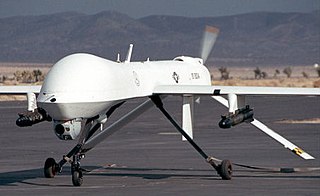
Military robots are autonomous robots or remote-controlled mobile robots designed for military applications, from transport to search & rescue and attack.
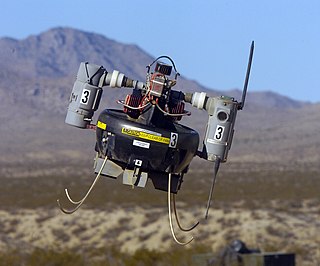
A micro air vehicle (MAV), or micro aerial vehicle, is a class of miniature UAVs that has a size restriction and may be autonomous. Modern craft can be as small as 5 centimeters. Development is driven by commercial, research, government, and military purposes; with insect-sized aircraft reportedly expected in the future. The small craft allows remote observation of hazardous environments inaccessible to ground vehicles. MAVs have been built for hobby purposes, such as aerial robotics contests and aerial photography.
Boeing Defense, Space & Security (BDS) is a division of The Boeing Company based in Arlington, Virginia. It is responsible for defense and aerospace products and services. It was formerly known as Boeing Integrated Defense Systems (IDS).

The Lockheed AH-56 Cheyenne was an attack helicopter developed by Lockheed for the United States Army. It rose from the Army's Advanced Aerial Fire Support System (AAFSS) program to field the service's first dedicated attack helicopter. Lockheed designed the Cheyenne using a four-blade rigid-rotor system and configured the aircraft as a compound helicopter with low-mounted wings and a tail-mounted thrusting propeller driven by a General Electric T64 turboshaft engine. The Cheyenne was to have a high-speed dash capability to provide armed escort for the Army's transport helicopters, such as the Bell UH-1 Iroquois.
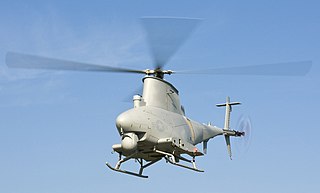
The Northrop Grumman MQ-8 Fire Scout is an unmanned autonomous helicopter developed by Northrop Grumman for use by the United States Armed Forces. The Fire Scout is designed to provide reconnaissance, situational awareness, aerial fire support and precision targeting support for ground, air and sea forces. The initial RQ-8A version was based on the Schweizer 330, while the enhanced MQ-8B was derived from the Schweizer 333. The larger MQ-8C Fire Scout variant is based on the Bell 407.

The Boeing A160 Hummingbird is an unmanned aerial vehicle (UAV) helicopter. Its design incorporates many new technologies never before used in helicopters, allowing for greater endurance and altitude than any helicopter currently in operation.
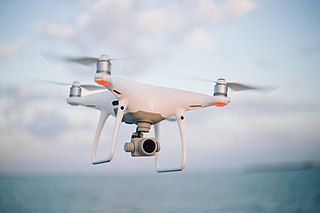
A quadcopter or quadrotor is a type of helicopter with four rotors.

A laser weapon is a directed-energy weapon based on lasers. After decades of R&D, as of January 2020 directed-energy weapons including lasers are still at the experimental stage and it remains to be seen if or when they will be deployed as practical, high-performance military weapons. Atmospheric thermal blooming has been a major problem, still mostly unsolved, and worsened if fog, smoke, dust, rain, snow, smog, foam, or purposely dispersed obscurant chemicals are present. Essentially, a laser generates a beam of light which needs clear air, or a vacuum, to work without thermal blooming.
Arse or ARSE may refer to:

The Kaman K-MAX is a helicopter with intermeshing rotors (synchropter) designed and produced by the American manufacturer Kaman Aircraft.
Dr. Imraan Faruque is an American who is most known as a designer and author in the unmanned aerial vehicle (UAV) field. He is the designer responsible for a variety of UAVs, including several currently operational in Iraq, the most well-known being the R-series UAVs which are based on commercial airframes, along with work on Insitu's ScanEagle. These vehicles are normally deployed as a part of reconnaissance missions as they are unarmed but carry either a significant camera or FLIR unit.

The Agency for Defense Development (ADD) is the South Korean national agency for research and development in defense technology, funded by the Defense Acquisition Program Administration (DAPA). It was established in August 1970 under the banner of the self-reliable defense. Its purpose is contributing to enforcing the national defence, to improving the national R&D capacity, and to fostering the domestic defense industry. ADD focuses on core weapons systems and core technology development, and studies major weapons platforms in high-risk and non-economical fields, unmanned and advanced, and new weapon systems for the future.

The Boeing AH-6 is a series of light helicopter gunships based on the MH-6 Little Bird and MD 500 family. Developed by Boeing Rotorcraft Systems, these include the Unmanned Little Bird (ULB) demonstrator, the A/MH-6X Mission Enhanced Little Bird (MELB), and the proposed AH-6I and AH-6S.
The Indian Air Force has been undergoing a modernization program to replace and upgrade outdated equipment since the late 1990s to meet modern standards. For that reason, it has started procuring and developing aircraft, weapons, associated technologies, and infrastructures. Some of these programs date back to the late 1980s. The primary focus of current modernization and upgrades is to replace aircraft purchased from the Soviet Union that currently form the backbone of the Air Force.
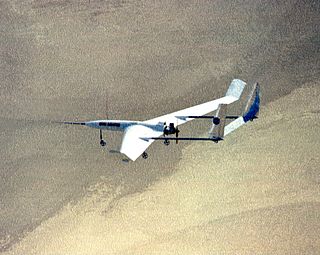
A Mars aircraft is a vehicle capable of sustaining powered flight in the atmosphere of Mars. So far, the Mars helicopter Ingenuity is the only object to ever fly on Mars, completing 39 successful flights covering 7.90 km (4.91 mi) in 1 hour, 4 minutes and 20 seconds of flight time.
ArduPilot is an open source, unmanned vehicle Autopilot Software Suite, capable of controlling autonomous:

The Defense Acquisition Program Administration (DAPA) was founded on January 1, 2006 as part of a comprehensive reform of the defense acquisition project, including the introduction and development of weapons, and is a central administrative agency of the South Korean Ministry of National Defense.
References
- 1 2 Page, Lewis (21 April 2009). "Flying-rifle robocopter: Hovering sniper backup for US troops". The Register . Archived from the original on 24 April 2009. Retrieved 2009-04-21.
- 1 2 3 4 5 Hambling, David (May 2009). "UAV Helicopter Brings Finesse to Airstrikes". Popular Mechanics . Archived from the original on 21 April 2009. Retrieved 2009-04-21.
- ↑ Hambling, David (April 21, 2009). "Army Tests Flying Robo-Sniper". Wired, "Danger Room" blog. Archived from the original on 23 April 2009. Retrieved 2009-04-21.
- 1 2 "ARSS - Autonomous Rotorcraft Sniper System". Space Dynamics Laboratory. Archived from the original on 19 April 2009. Retrieved 2009-04-21.
- ↑ "U.S. Army Tests Flying Robot Sniper". Fox News. 2009-04-22. Archived from the original on 26 April 2009. Retrieved 2009-04-23.
- ↑ McHale, John. Laser-based sniper system ordered by DARPA from Lockheed Martin Military AeroSpace 18 December 2010. Accessed: 19 February 2011.